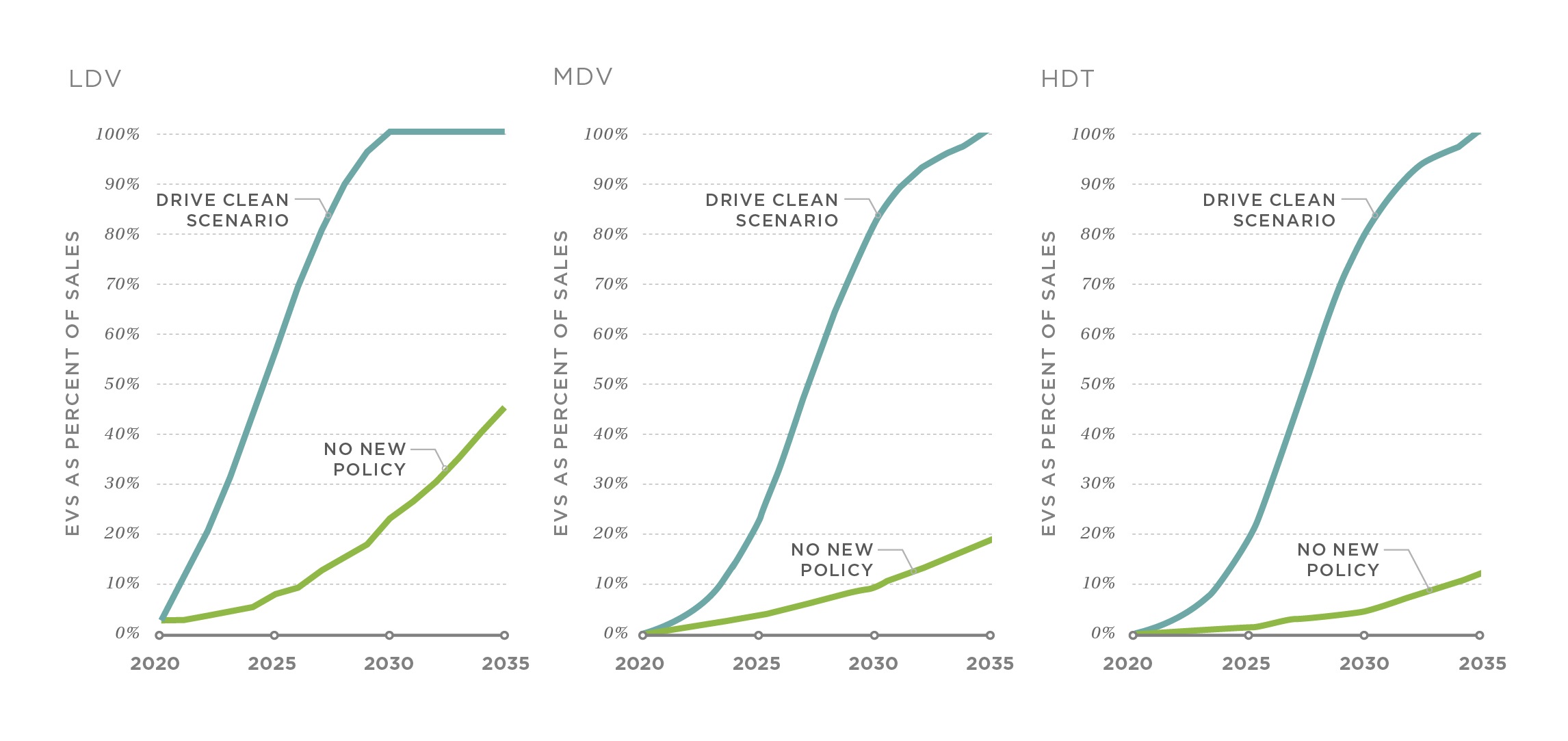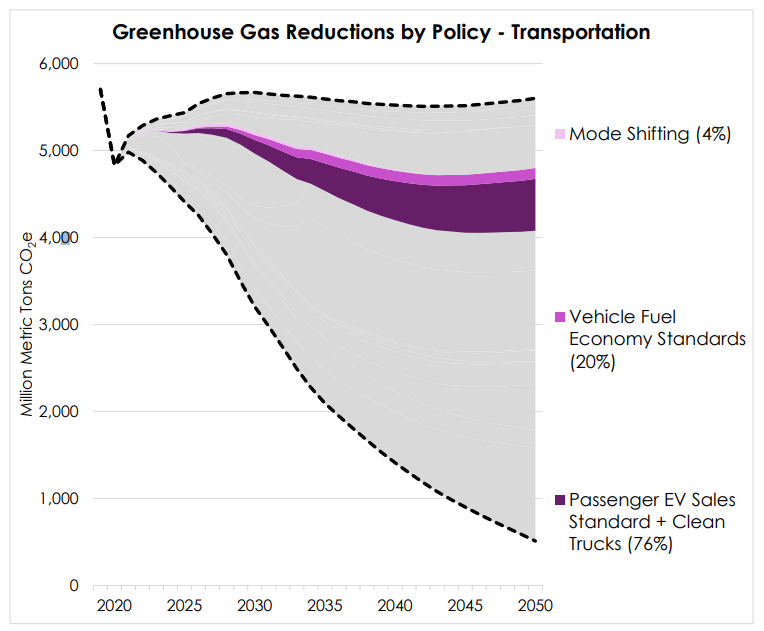The following is a contributed article by Amanda Myers, senior policy analyst at Energy Innovation.
The Biden administration recently unveiled a $2 trillion plan to modernize U.S. infrastructure, build an equitable clean energy economy, and stimulate recovery from COVID-19. A major focus of the "Build Back Better" plan is on transportation electrification, and now, new research shows vehicle electrification, and the associated infrastructure buildout needed to support it, could happen faster than previously thought, while delivering major economic, climate and health benefits.
Researchers at University of California, Berkeley, Energy Innovation and GridLab analyzed the latest battery and infrastructure costs and found that the transition to 100% electric car sales by 2030 and all-electric truck sales by 2035 (or all electric vehicle sales by 2030/2035), combined with a 90% clean electricity grid by 2035, could deliver $2.7 trillion in consumer savings through 2050, or an average of $1,000 per household every year, while also creating 2 million jobs in 2035, and reducing economy-wide emissions 45% by 2030. However, these benefits will not be realized without smart policy to accelerate electric vehicle (EV) adoption and unlock advantages ranging from global competitiveness to improved public health.
Steering toward a competitive, clean energy economy
The transportation sector is the largest source of greenhouse gas emissions in the U.S. To limit global warming to 1.5 degrees Celsius by midcentury and avoid the worst consequences of climate change, we must stop burning fossil fuels to power our cars and trucks. The average vehicle lifetime ranges from 15 to 30 years, so turning over the entire vehicle fleet is slow. We need to implement electric car and truck sales requirements now to shift to a zero-emissions fleet by midcentury.

Transportation sector CO2 emissions in the DRIVE Clean and No New Policy scenarios through 2050.
Permission granted by GridLab and the UC Berkeley Goldman School of Public Policy
Targeting 100% all-electric car and truck sales by 2030/2035 is ambitious, but several countries and California have recently adopted these targets, and other states are following suit. California, which has recently seen EVs emerge as the top manufacturing export, just established a 100% zero-emissions sales target for light-duty cars that sets the state up to be a major player in the global EV market. Massachusetts followed fast with a 100% EV sales target by 2035 and New Jersey's Governor has expressed interest in pursuing a similar policy.

EVs as percentages of sales by vehicle category in the No New Policy and DRIVE Clean scenarios.
Permission granted by GridLab and the UC Berkeley Goldman School of Public Policy
But the EU and China are still well ahead of the U.S. It's anticipated that by 2025, the EU will have double the amount of battery manufacturing capacity than the U.S. and China more than seven times the U.S. projected capacity. The U.S. needs to catch up by investing in a domestic supply chain and manufacturing, and it's clear President Biden recognizes the opportunity to achieve multiple economic, public health and climate goals through a strong EV market strategy.
Biden's recently released American Jobs Plan will pave the way towards equitable widespread transportation with its goals of $174 billion investment in the EV market, 500,000 installed charging stations by 2030, electrifying at least 20% of the school bus fleet, point-of-sale EV rebates and tax incentives, and building a resilient clean power system that underpins this entire transition. The plan also includes $52 billion to increase domestic manufacturing of EVs and the EV supply chain, while supporting transportation sector workers throughout the transition. These are necessary actions to accelerate transportation electrification, but additional, key vehicle transportation policies could really kick the EV transition into high gear.
Going full speed ahead on electrification drives major benefits
The 2035 Report 2.0: Plummeting Costs and Dramatic Improvements in Batteries Can Accelerate our Clean Transportation Future evaluates the impacts of achieving 100% light-duty EV sales by 2030 and 100% medium- and heavy-duty EV sales by 2035, combined with a 90% clean electricity grid by 2035 (or DRIVE Clean scenario), compared to a business-as-usual (No New Policy) scenario, and finds rapid transportation decarbonization is cost-effective and feasible through vehicle electrification.
The study represents an important follow-up to the original 2035 Report, showing that a 90% clean grid can handle additional demand due to electrification without raising costs from today's levels, but that additional capacity will be required by about 120 gigawatts per year of wind, solar and storage. This is a stringent pace, but not unprecedented internationally – China installed 120 gigawatts of wind and solar capacity in 2020 alone.

U.S. electricity capacity additions in the DRIVE Clean scenario, 2021–2035.
Permission granted by GridLab and the UC Berkeley Goldman School of Public Policy
Rapid investments in public charging are needed, at the scale of $10 billion per year. This equates to installing approximately 300,000 public Level 2 and fast charging chargepoints per year over the next 30 years. While this is a significant investment, it is modest in comparison to recent distribution system investments by utilities, which historically average around $30 billion per year.

Average annual capital investment in public L2 charging, public DCFC and public MDV/HDT DCFC necessary to support the DRIVE Clean scenario, 2020–2050, compared with average annual capital investment in public distribution system upgrades, 2010–2020. To illustrate public investment, we include only public charging infrastructure needs in this chart, not private home or workplace charging.
Permission granted by GridLab and the UC Berkeley Goldman School of Public Policy
In addition to the technological feasibility of all-electric vehicle sales by 2035, the researchers found the benefits of all-electric vehicle sales by 2030/2035 are large and wide-ranging:
Consumer benefits
The study finds that consumers will save a total of $2.7 trillion between 2020 and 2050, or about $100-200 billion per year over 30 years, due in large part to greater efficiency of electric motors and lower refueling costs. This translates to average household savings of $1,000 every year. Including environmental benefits, the savings exceed $4 trillion over the 30-year period. Alternatively, the researchers found a delay of just five years in the passenger vehicle target, or 100% light-duty EV sales by 2035, defers over $400 billion in consumers savings.

Annual consumer savings in the DRIVE Clean scenario (cumulative savings of $2.7 trillion through 2050) and a delayed-electrification scenario (cumulative savings of $2.2 trillion through 2050).
Permission granted by GridLab and the UC Berkeley Goldman School of Public Policy
Public health & climate benefits
Ground transportation pollution-related premature deaths fall 56% by 2035 and 96% by 2050. In total, 150,000 total deaths are avoided by 2050. Additionally, ground transportation greenhouse gas emissions fall 60% by 2035 and 93% by 2050, with economy-wide emissions dropping 45% by 2030.

Annual premature deaths in the No New Policy and DRIVE Clean scenarios, 2020–2050. The DRIVE Clean scenario avoids 150,000 premature deaths due to air pollution through 2050.
Permission granted by GridLab and the UC Berkeley Goldman School of Public Policy
Job creation
Rapid transportation electrification and grid decarbonization increases net employment by 2 million jobs in 2035, driven by electrical infrastructure buildout and induced jobs due to large consumer savings, and more than make up for lost vehicle maintenance jobs – though transition policies are needed.

Change in direct, indirect and induced jobs in the DRIVE Clean scenario compared to the No New Policy scenario, 2020-2035.
Permission granted by GridLab and the UC Berkeley Goldman School of Public Policy
Policy shifts the transition into high gear
Without strong policy to reach 100% EV sales and 90% clean electricity targets, Americans will forgo significant benefits and miss the chance to steer towards a better future. Federal, state and local policymakers and other stakeholders can take bold actions, bolstered by the widespread support among Americans, for more aggressive policy action to capture trillions in customer savings, improve environmental justice and address climate change. The American Jobs Plan takes significant initial steps in this direction. Additional regulatory action by the Biden administration can accelerate the transition and realize cleaner air and consumer savings for millions of American households.
A companion report from Energy Innovation and the Goldman School of Public Policy identifies the top policy priorities to achieve clean, electrified transportation by 2030/2035:
Strong national fuel economy and tailpipe emissions standards for all vehicle classes will pave the way for market transformation, spur innovation, reduce local pollution and lock in consumer savings. Combined with state leadership in zero-emission vehicle standards, strong national standards are essential to 100% electric vehicles sales by 2035, and are the highest priority policies in terms of emissions reductions – America needs strong standards to reduce greenhouse gas emissions in line with a 1.5 degree Celsius global target.

The transportation policies shown here reflect their contributions to overall emissions reductions, shown in percentages. Of note, this model run assumed 100% EV sales for LDVs by 2035 and HDVs by 2045, which are slower timelines than those modeled in the 2035 2.0 Report. Moving the timeline to align with 2035 2.0 Report DRIVE Clean scenario would have the effect of accelerating the overall emissions reductions, among other benefits.
Permission granted by Energy Innovation
Equity-focused policies and programs designed with input from communities most adversely impacted by transportation pollution – namely communities of color in historically redlined neighborhoods, and frontline and underserved communities – will ensure all people, regardless of race or other socio-economic demographics benefit from cleaner, more efficient transportation solutions.
Targeted consumer incentives that ramp down over time as the market matures will encourage early adoption and drive down purchase costs. Means-based incentives will help ensure low- and moderate-income consumers and small businesses also benefit. Consumer education programs to increase awareness of expanding EV model availability and suitability will increase consumer comfort with the new technology and increase EV adoption. Incentive programs for EV infrastructure are also key to an all-electric future.
Investments in a ubiquitous charging network and a modern grid will address range anxiety and ensure reliability as the EV market grows. Meeting the mobility needs of families and businesses will boost consumer and business confidence in EVs for urban, rural and long-distance trips.

LDV public charging infrastructure per zip code by 2050, prioritized by low availability of dedicated home charging (implying higher concentrations of multi-dwelling and rented units), low-income areas, and higher vehicle populations in the region.
Permission granted by GridLab and the UC Berkeley Goldman School of Public Policy
Strong "Made in America" policies to encourage domestic manufacturing will help retool U.S. industries to manufacture batteries, EVs, energy storage and other advanced technologies. An early focus on these policies is critical if the U.S. is to be competitive globally, and to create and sustain jobs, while also supporting workers in the transition.
Smart electric utility regulations and local government leadership will reduce permitting and other soft costs and elicit full transportation electrification value for the benefit of EV owners, utility customers and the grid. Efforts to streamline interconnection and integration of EVs in homes, businesses and communities will pay dividends as demand grows.
Let's drive forward towards jobs, health and climate safety
If adopted by Congress, the American Jobs Plan will transform and strengthen our transportation system, create new jobs, clean our air and avert significant climate damage. But we also need additional regulatory action to electrify all new cars by 2030 and all new medium- and heavy-duty trucks by 2035. The UC Berkeley, GridLab and Energy Innovation research shows that rapid ground transportation electrification promises tremendous benefits and is cost-effective and feasible with expeditious power sector decarbonization. We can put America back to work by leading the world in electric vehicle technology innovation while getting fossils fuels out of our economy.
"electric" - Google News
April 19, 2021 at 08:33PM
https://ift.tt/3aluwze
All-electric car and truck sales by 2035 would save $2.7 trillion, but will take smart policy to drive clean - Utility Dive
"electric" - Google News
https://ift.tt/2yk35WT
https://ift.tt/3bbj3jq
No comments:
Post a Comment